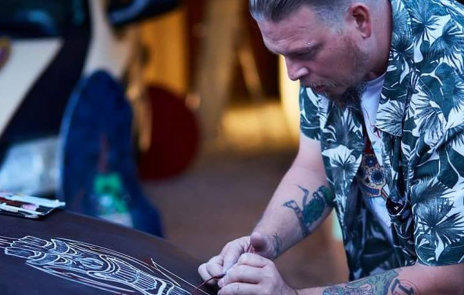
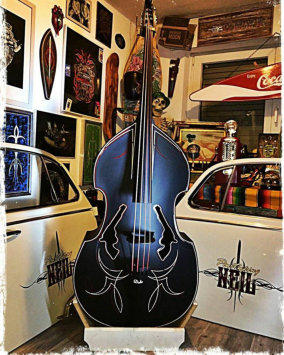





Pinstriping is one of the oldest arts and crafts. Even the ancient Romans decorated their chariots with
decorative lines. Until the middle of the last century, however, it practically did not develop at all. As has
been the case for eons, the lines always followed the contours of the object that surrounded them, from
the book cover to the bicycle frame. Then, around 1953, strange, bizarre tangles of lines suddenly
appeared on the converted cars of young men in Southern California. At first only on the glove box lids,
two years later they grew around the radiator grille, behind the wheel arches, over trunk lids, C-pillars
and door latch plates. Freestyle pinstriping was born. The invention of freestyle pinstriping is generally
attributed to Von Dutch (Kenneth Howard, 1929-1992). Tommy the Greek (Tommy Hrones, 1906-2002)
was Von Dutch's forerunner, famous for his mastery and his teardrops. His stripings, however, remained
classic for all their complexity and had nothing of Von Dutch's bizarre hectic pace. These two and Ed
Roth (1932-2001), who started out as a pinstriper and later achieved immortal fame in the custom car
world with his moving sculptures, were the most famous pinstrippers of this first golden age. From
about 1965 to 1985 the interest in pinstriping was almost extinguished. The custom car wave was
replaced by the pop wave with the arrival of the Beatles. (Roth: Guys wuz buyin' guitars instead of cars).
Material possessions such as an artistically crafted custom car had been abandoned under the emerging
ideals of the hippies and were considered uncool. In the 1970s, various new custom styles emerged -
vans, pro street, lowrider, off-roader, billet - which were either completely unadorned or airbrushed,
often in mural form. Airbrush began to establish itself as the dominant decorative form on car panels,
and it still holds this position today. Around 1990, a method similar to pinstriping was added to the
purely abstract motifs: the tribal. However, it is almost never painted, but only pasted, printed or
tattooed. Its formal language is based on the art of various primitive peoples - mainly the Māori and the
Celts - and it can still be found on cars, on the arms of their drivers and above the back of the car (tramp
stamp). In the early 1990s, however, the early customs styles began to be rediscovered. These people -
often retro-inspired rockabillys anyway - no longer sprayed their old cars in shiny pastel or neon shades,
but in matte primer, and instead of hi-tech billet attachments, they emphasized authentic, old accessories:
SV engines, steel rims, cheater slicks. This also made pinstriping popular again. (Source: WIKIPEDIA)
T
- Pinstriping -- Lettering - Custompainting -
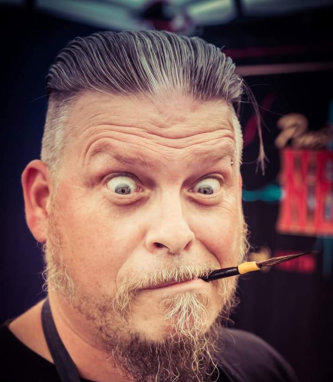



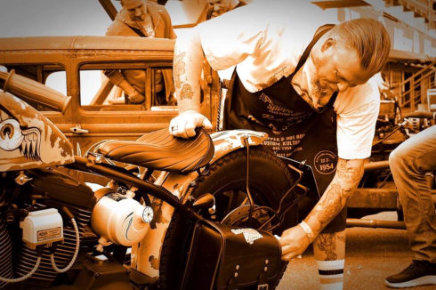
- Pinstriping -- Lettering -
Custompainting -

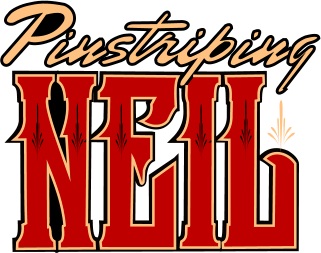






Linierung ist eines der ältesten Kunsthandwerke.
Schon die alten Römer dekorierten ihre Streitwagen
mit Zierlinien. Bis zur Mitte des letzten Jahrhunderts
jedoch entwickelte es sich praktisch überhaupt nicht
weiter. Die Linien folgten wie schon seit Äonen
immer brav den Konturen des Objekts, welches sie
umgab, vom Buchdeckel bis zum Fahrradrahmen.
Dann, etwa 1953, tauchten in Südkalifornien auf
einmal seltsame, bizarre Liniengewirre auf den
umgebauten Autos junger Männer auf. Zuerst nur
auf den Handschuhfachdeckeln, wuchsen sie zwei
Jahre später um die Kühlergrille, hinter die Radläufe,
über Kofferdeckel, C-Säulen und Türfallen. Freestyle
Pinstriping war geboren. Die Erfindung des Freistil-
Linierens wird im Allgemeinen Von Dutch (Kenneth
Howard, 1929–1992) zugeschrieben. Tommy the
Greek (Tommy Hrones, 1906–2002) war Von Dutchs
Vorreiter, berühmt für seine Meisterschaft und seine
Teardrops. Seine Stripings blieben jedoch bei aller
Kompliziertheit klassisch und hatten nichts von der
bizarren Hektik Von Dutchens. Diese beiden und Ed
Roth (1932–2001), der als Pinstriper anfing und es
später mit seinen fahrenden Skulpturen zu
unsterblichem Ruhm in der Custom-Autowelt
brachte, waren die bekanntesten Pinstriper dieses
ersten goldenen Zeitalters.
Von etwa 1965 bis 1985 war dann das Interesse an
Pinstriping fast erloschen. Die Custom-Car-Welle
wurde mit der Ankunft der Beatles durch die
Popwelle abgelöst. (Roth: Guys wuz buyin´ guitars
instead of cars). Materieller Besitz wie ein kunstvoll
gefertigtes Custom Car war unter den
aufkommenden Idealen der Hippies abgesagt, galt
als uncool.
In den 1970er Jahren entstanden verschiedene neue
Customstile – Vans, Pro Street, Lowrider, Offroader,
Billet – die entweder völlig schmucklos waren oder
mit Airbrush, oftmals in Mural (Wandgemälde)-
Form verziert. Airbrush begann sich als
beherrschende Dekorationsform auf Autoblechen
durchzusetzen, und bis heute hat es diese Position
inne. Bei den rein abstrakten Motiven gesellte sich
um 1990 eine dem Pinstriping ähnelnde Art hinzu:
das Tribal. Es wird allerdings fast nie gemalt,
sondern nur aufgeklebt, gedruckt oder tätowiert. In
der Formensprache an die Kunst verschiedener
Naturvölker – hauptsächlich der Māori und der
Kelten – angelehnt, findet es sich bis heute auf Autos,
auf den Armen ihrer Fahrer und über dem Hinterteil
(Arschgeweih).
In den frühen 1990er Jahren jedoch begann man, die
frühen Customstile wiederzuentdecken. Diese Leute
– oft sowieso Retro-begeisterte Rockabillys –
spritzten ihre alten Autos nicht länger in glänzenden
Pastell- oder Neontönen, sondern in matter
Grundierung, und statt Hi-Tech-Billet-Anbauteilen
wurde auf authentisches, altes Zubehör Wert gelegt:
SV-Motoren, Stahlfelgen, Cheater Slicks. So wurde
auch das Pinstriping wieder populär.
(Quelle: WIKIPEDIA)

















